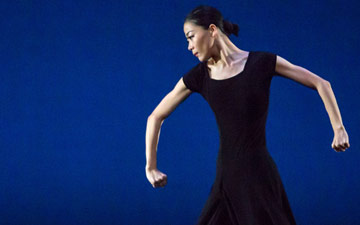
© Melissa Sherwood. (Click image for larger version)
Martha Graham Dance Company
Graham Deconstructed: El Penitente, Hérodiade
★★★✰✰
New York, Martha Graham Studios
15 January 2019
www.marthagraham.org
Graham Revealed
Last night, the Graham Deconstructed series offered a glimpse of two early-ish works by Martha Graham being revived for the spring season, which the company, as is its wont, is branding “The Eve Project.” Both El Penitente and Hérodiade are from the 40’s, a period when Graham was transitioning from exploration of American and Native-American themes to a more mythical mode.
El Penitente, from 1940, is like a medieval passion play, and probably draws, more specifically, from Mexican religious folk theatre. The three dancers represent “players” in a religious pageant: the Penitent (a sculptural and intense Lloyd Knight), a Christ Figure in a ghoulish mask (the monumental Ben Schultz), and a woman playing, in sequence, the Virgin Mary, Mary Magdalen, the Mary of the Crucifixion (Anne O’Donnell). Each section represents an aspect of religious symbolism: penitence and self-flagellation, Eve’s temptation of Adam in the Garden of Eden, Sin, Prayer, Crucifixion. As in a folk pageant, the players use Noguchi’s simple props to represent important images in the stories being told (a rope, a cart, a banner, a cowl-like veil). In between, Graham “wipes” the stage with flat, hieroglyphic-like walking steps. Louis Horst’s music is spare, with harmonies that echo medieval incidental music.

© Melissa Sherwood. (Click image for larger version)
Hérodiade, made 4 years later—the same year, in fact, as Appalachian Spring—is Graham in her ferocious female mode. Hérodias (Xin Ying), mother of Salomé, wife of Herod, is contemplating the murder of St. John the Baptist, while her attendant (Anne Souder) pleads, tends to her, argues with her. The Noguchi set consists of three pieces, in bone-like white: a “mirror,” a chair, and a wardrobe containing a figure that suggests a bird, which, according to Graham, represented Hérodias’s heart. Like other dances in a similar vein in the Graham oeuvre (Cave of the Heart, Errand into the Maze, Clytemnestra) the woman’s internal conflict is abstracted, rendered symbolic and universal. Hérodias is all women who must choose, no matter how dark the choice, Graham implies; or, in another interpretation, she is the artist taking the hard path; or, more simply, she is a projection of Graham herself. Here, the music, by Paul Hindemith, plays a more active role than in El Penitente, where it can be seen more as descriptive accompaniment. Instead, Hindemith’s Hérodiade stands on its own, both as music and as a distillation of the story. In other words, you can close your eyes and still “hear” Hérodias’s thoughts, see her presence in your mind’s eye.
Xin Ying played the title role with great intensity and a muscular, sculptural approach to the steps—in her signature pose she holds one arm up, in front of her, and the other slightly lower and rounder, behind. Thus, she turns her body into a weapon, immutable, driven by fate and will. Her eyes flame. For the duration of the piece, Ying appeared older than her years, hard, angular, unflinching. As her attendant, Anne Souder was slender, delicate, but also severe and slightly sinister, alternately cowering and attempting to dominate her mistress. Souder may be too slight for the role; her impact fluctuated over the course of the work.
Graham’s eye for the dramatic use of garment provides the final coup de theater. As Hérodias envelops herself in a black cloak, she becomes death itself, her arm, now concealed, extended upward like a noose or a guillotine, ready to fall.

















You must be logged in to post a comment.